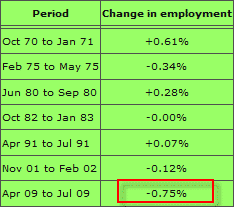Revisiting employment indicators for signs of recovery
If you recall, at the end of May, I wrote a post “Both initial claims and continuing claims now pointing to recovery” that said jobless claims data were pointing to an imminent recovery. The general gist of my argument was recovery would come by year’s end or early in 2010. But we needed to focus on the shape that recovery would take. Although claims data suggested recovery was right around the corner, we should be sceptical as to how soon this recovery would come and how robust it would be due to the overhang of low savings and high debt – what Richard Koo calls a balance sheet recession.
That post generated a lot of negative commentary because it has become fashionable to be all bearish all the time in the econoblogosphere. But, reality is almost never as extreme as some would have you believe. In that vein, do re-read the jobless claims post. Three months on, it is looking a lot more on target than it might have done in May.
I mention this because James Hamilton over at Econbrowser has a nice post up called “It’s not over yet” which dovetails nicely with the themes in my May post. In May, I ended the post saying:
The real question is how robust a recovery are we going to have and this is directly related to why the jobless claims series has been sending a false signal. Now, initial claims has been sending a recovery signal since January. Yet, continuing claims continued to rise more quickly until last week. In the past, one had seen these two series as harbingers of imminent recovery. But, I am talking Q4 here. Why? Deleveraging.
In the end, consumers are going to be forced to reduce debt and save more in this more cautious financial environment. Team Obama does seem intent on re-kindling animal spirits but the personal savings rate has gone up nonetheless. This will be a drag on GDP growth going forward and means that the economy’s rebound will be more tenuous and slower to develop. In my view, this means recovery will be delayed and once it gets going it will be weak. The potential for a double dip is very high.
So, to be clear, first derivatives are starting to turn up and since recession is a first derivative event, we are probably going to see an end to this recession soon enough. But, with structural problems still remaining, the U.S. economy will be weak for a long time to come.
And I still hold to those comments. If anything, my comments were too bearish regarding when a technical recovery would take hold. Just yesterday, Hamilton made a similar argument:
Some are greeting Friday’s employment report as an all-clear signal. But my advice is, keep your helmet on– they’re still shooting real bullets out there.
Let’s start with the good news. I first called attention to the favorable turn in new claims for unemployment insurance on April 9, noting that in each of the previous 6 recessions, an economic recovery began within 8 weeks of the peak in new claims. On May 7, I concluded we had enough statistical evidence to predict with 85% confidence that new claims for unemployment insurance had indeed peaked at the beginning of April. Although there was some concern as to whether seasonal adjustment could be confounding the July readings, it’s pretty clear now that the substantial decline in new claims is the real deal.
And many cheered Friday’s BLS release showing that nonfarm payroll employment fell by 247,000 workers in July, the smallest drop since August, 2008. But the problem is, if a traditional economic recovery had actually begun in June (8 weeks after the April peak in claims), the number of people with jobs should have increased in July rather than fallen by another quarter million.
Hamilton goes on to say that he has done some figures on where employment numbers should be in comparison to previous peak in unemployment claims. The chart below shows where he comes out:
Notice how much of an outlier to the negative 2009 data is. What does this mean? For Hamilton and a lot of other economists (Krugman, Roubini, and Stiglitz for example), it means just what I said in May – “we are probably going to see an end to this recession soon enough. But, with structural problems still remaining, the U.S. economy will be weak for a long time to come.”
To my mind, the real question now is whether weak consumer demand couples with other lingering problem areas like commercial real estate to bring any technical recovery down before it starts. If we do experience a double dip, the second leg of the recession will likely be even worse than this leg. Policy makers would be well-advised to address these problems here and now rather than waiting for them to take full form.

Comments are closed.